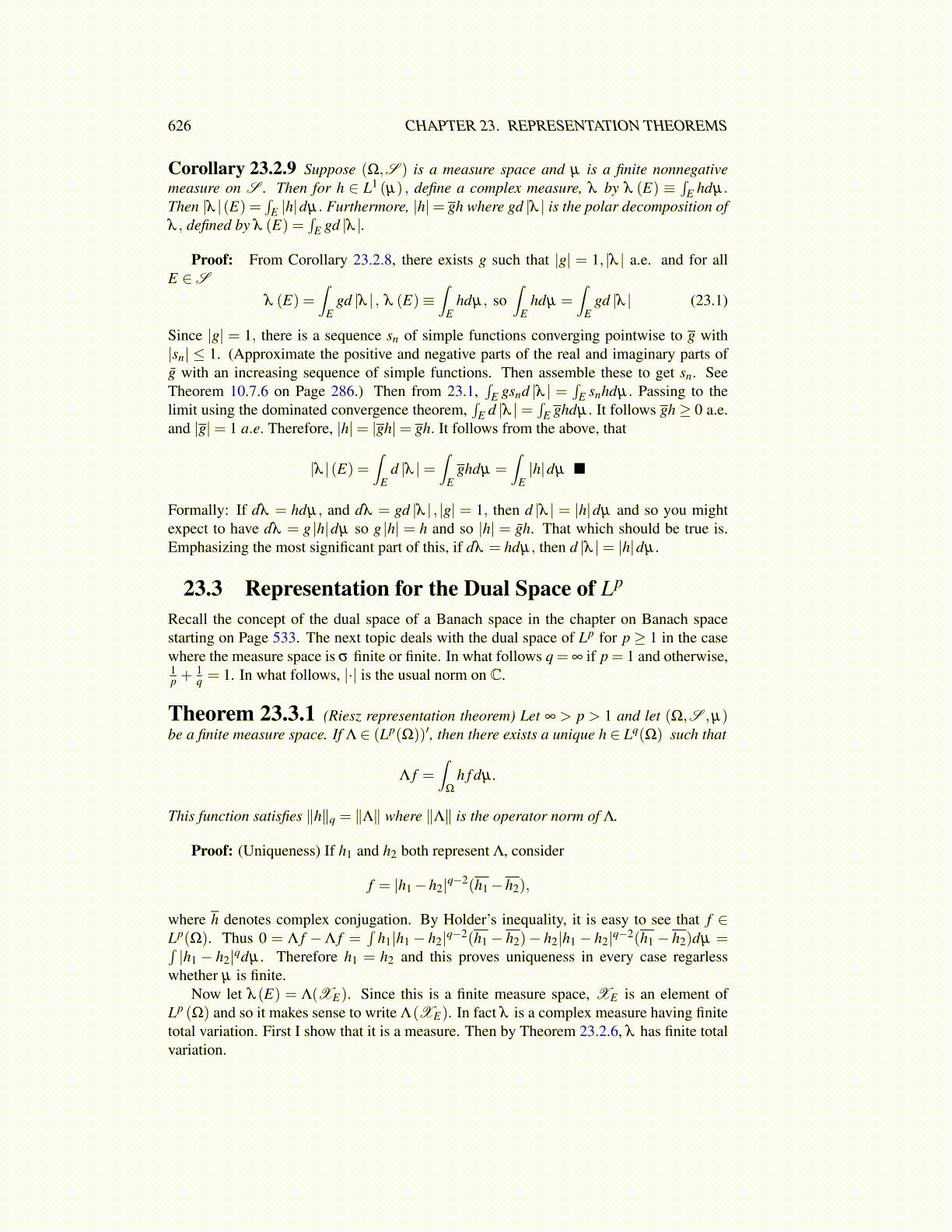
626 CHAPTER 23. REPRESENTATION THEOREMS
Corollary 23.2.9 Suppose (Ω,S ) is a measure space and µ is a finite nonnegativemeasure on S . Then for h ∈ L1 (µ) , define a complex measure, λ by λ (E) ≡
∫E hdµ.
Then |λ |(E) =∫
E |h|dµ. Furthermore, |h|= gh where gd |λ | is the polar decomposition ofλ , defined by λ (E) =
∫E gd |λ |.
Proof: From Corollary 23.2.8, there exists g such that |g| = 1, |λ | a.e. and for allE ∈S
λ (E) =∫
Egd |λ | , λ (E)≡
∫E
hdµ, so∫
Ehdµ =
∫E
gd |λ | (23.1)
Since |g| = 1, there is a sequence sn of simple functions converging pointwise to g with|sn| ≤ 1. (Approximate the positive and negative parts of the real and imaginary parts ofḡ with an increasing sequence of simple functions. Then assemble these to get sn. SeeTheorem 10.7.6 on Page 286.) Then from 23.1,
∫E gsnd |λ | =
∫E snhdµ. Passing to the
limit using the dominated convergence theorem,∫
E d |λ |=∫
E ghdµ. It follows gh≥ 0 a.e.and |g|= 1 a.e. Therefore, |h|= |gh|= gh. It follows from the above, that
|λ |(E) =∫
Ed |λ |=
∫E
ghdµ =∫
E|h|dµ ■
Formally: If dλ = hdµ, and dλ = gd |λ | , |g| = 1, then d |λ | = |h|dµ and so you mightexpect to have dλ = g |h|dµ so g |h| = h and so |h| = ḡh. That which should be true is.Emphasizing the most significant part of this, if dλ = hdµ, then d |λ |= |h|dµ .
23.3 Representation for the Dual Space of Lp
Recall the concept of the dual space of a Banach space in the chapter on Banach spacestarting on Page 533. The next topic deals with the dual space of Lp for p ≥ 1 in the casewhere the measure space is σ finite or finite. In what follows q = ∞ if p = 1 and otherwise,1p +
1q = 1. In what follows, |·| is the usual norm on C.
Theorem 23.3.1 (Riesz representation theorem) Let ∞ > p > 1 and let (Ω,S ,µ)be a finite measure space. If Λ ∈ (Lp(Ω))′, then there exists a unique h ∈ Lq(Ω) such that
Λ f =∫
Ω
h f dµ .
This function satisfies ∥h∥q = ∥Λ∥ where ∥Λ∥ is the operator norm of Λ.
Proof: (Uniqueness) If h1 and h2 both represent Λ, consider
f = |h1−h2|q−2(h1−h2),
where h denotes complex conjugation. By Holder’s inequality, it is easy to see that f ∈Lp(Ω). Thus 0 = Λ f −Λ f =
∫h1|h1− h2|q−2(h1− h2)− h2|h1− h2|q−2(h1− h2)dµ =∫
|h1 − h2|qdµ . Therefore h1 = h2 and this proves uniqueness in every case regarlesswhether µ is finite.
Now let λ (E) = Λ(XE). Since this is a finite measure space, XE is an element ofLp (Ω) and so it makes sense to write Λ(XE). In fact λ is a complex measure having finitetotal variation. First I show that it is a measure. Then by Theorem 23.2.6, λ has finite totalvariation.